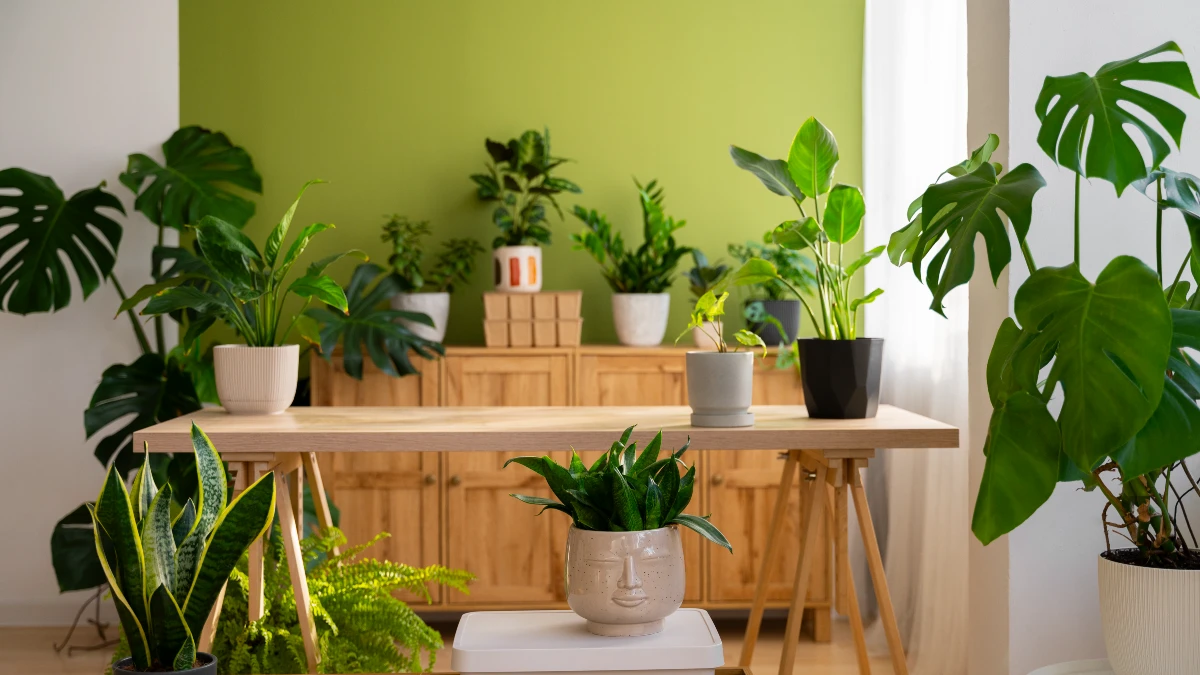If every plant you buy turns into compost, this guide is your comeback plan. Most “black thumbs” don’t fail from neglect—they misjudge light and water. Indoors is shockingly dim for plants:
University of Florida horticulture educators note a typical office can be around ~40 foot-candles (fc) and a north window may never reach 400 fc, which explains stalled growth even when you’re “doing everything right.” You’ll fix that today.
In this guide you’ll learn how to measure your light with a phone (so you can match plants to your actual conditions), set no-guess watering routines that prevent overwatering (the #1 plant killer), add simple grow-light support when needed, and pick 8–10 ultra-forgiving, low maintenance houseplants proven to tolerate low light or missed waterings.
You’ll also get pot/soil choices that reduce errors and a quick pet-safety check using the ASPCA toxic/non-toxic plant database. Expect specific targets, quick tests, and plant picks with extension-backed proof—so even beginner indoor plants thrive.
How to Choose Hard-to-Kill Plants for Your Light
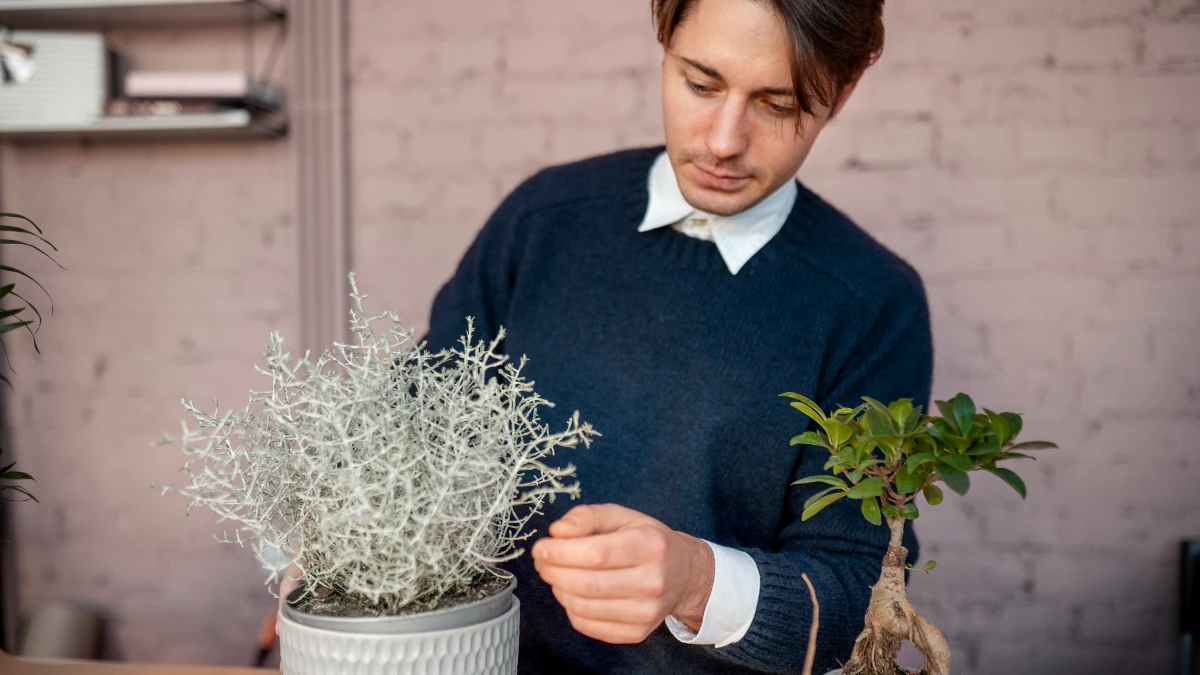
How bright is your room—really?
“Indoors can look bright to us, but plants see far less light—our eyes adapt, plants don’t.” — UF/IFAS Gardening Solutions
Why light is #1. Indoors, “bright rooms” are still dim for plants. Extension guidance translates common terms to measurable targets: low ≈ 50–250 fc; medium ≈ 250–1,000 fc (roughly 500–10,800 lux; use 1 fc ≈ 10.8 lux). Minnesota and Missouri extensions also frame medium light in the 250–1,000 fc band; UF/IFAS shows real-world examples (north windows under ~400 fc; offices ≈40 fc). This is why many “low-light” plants survive but don’t grow.
Phone light test (2 minutes).
- Install any light meter app (it reads lux).
- At leaf height at noon, hold your phone’s sensor toward the window or light.
- Convert: lux ÷ 10.8 ≈ fc; compare to the bands above. (Example: 1,080 lux ≈ 100 fc → “low”.)
If your light is too low, boost it. A simple LED grow light on a timer (no fancy rig) for 12–14 h/day stabilizes growth in foliage houseplants. Several extensions recommend this daily duration for indoor culture; set-and-forget timers make it effortless. Mount bars/bulbs so they’re 10–30 in above foliage (follow manufacturer guidance).
Placement cheat-sheet (hit your target without a meter).
~75 fc “low”: a few feet from a north window; 3–10 ft from east/west; 15–20 ft from south.
~150 fc “medium/average”: in front of north; a few feet from east/west; 3–10 ft from south.
~300 fc “bright/indirect”: in front of east/west; up to 5 ft from south.
Use this to choose truly hard-to-kill plants that match your light rather than fighting physics.
Watering That Prevents Overwatering
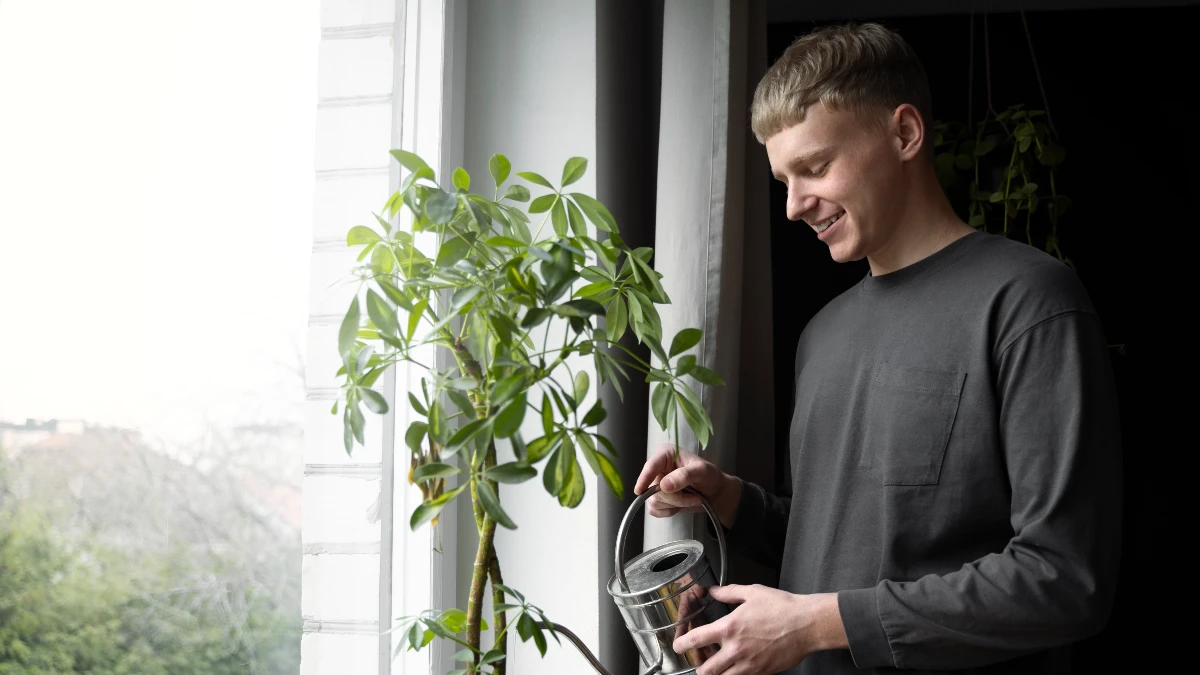
Fact: Overwatering is the top killer of houseplants. University extensions repeatedly tie root rot, yellowing leaves, and fungus gnats to soil that stays wet or pots that hold water in the saucer. So we water by soil dryness, not by the calendar.
Finger test first. Press a finger 1–2 in into the mix. If dry, water; if moist, wait. Minnesota Extension teaches exactly this rule of thumb.
Water thoroughly, then empty the saucer—don’t let roots sit in runoff. Bottom-watering works too: set the pot in 1–2 in of water 15–30 min until the top feels moist; remove and drain. This evenly hydrates the rootball and reduces splash on foliage.
Gnats? Let the top 1–2 in dry between waterings and use yellow sticky traps; consistently wet soil fuels their life cycle.
Set your pot to match your habits:
Terracotta (unglazed clay) breathes and dries faster—great if you tend to overwater or grow drought-tolerant plants.
Plastic/glazed ceramic hold moisture longer—useful if you forget to water. Colorado State’s PlantTalk explains these differences clearly.
Too busy to water? Self-watering planters (wicking reservoir + indicator) are legit training wheels. In recent hands-on tests, Better Homes & Gardens found models that can stretch refills to multiple weeks (e.g., Crescent Garden TruDrop up to ~6 weeks in favorable conditions). Use the gauge; refill before “empty” and still check the top inch of soil.
The 10 Easiest Indoor Plants
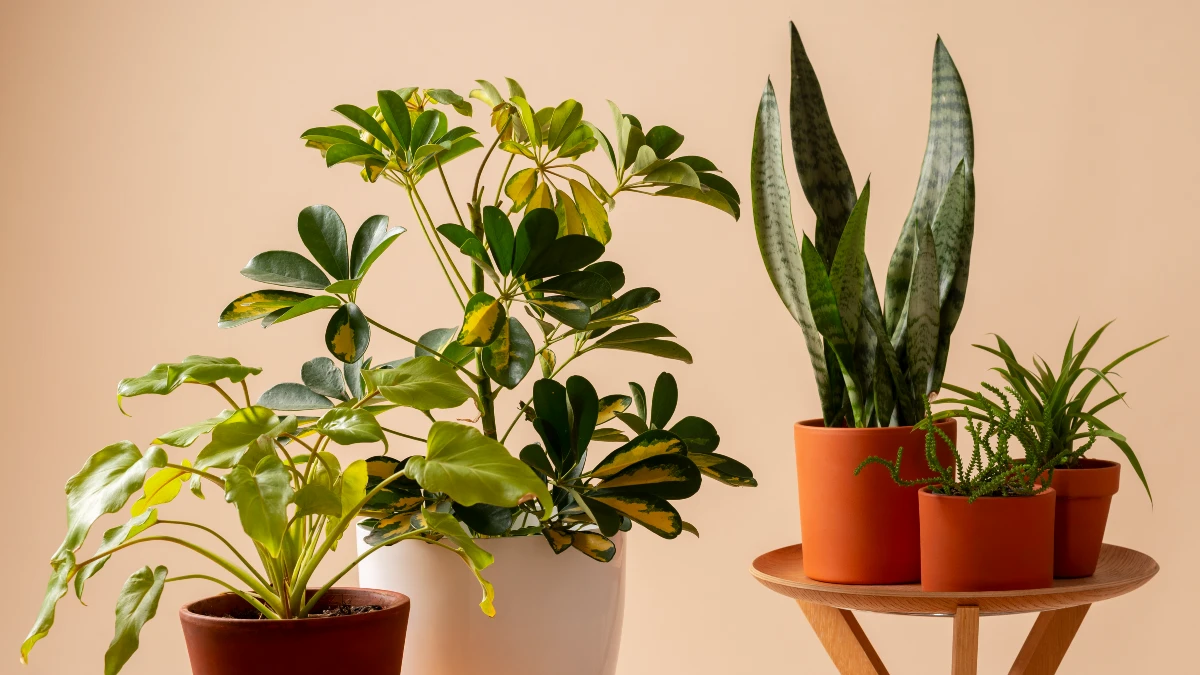
Below are mini care cards designed for low maintenance houseplants. Each includes light, watering, why it’s forgiving, and pet safety (check ASPCA for your exact variety).
1) ZZ Plant — Zamioculcas zamiifolia
- Light: Low to medium; tolerates very low light.
- Water: Infrequent; allow mix to dry deeply.
- Why forgiving: Thick rhizomes store water; University of Florida fact sheets highlight extreme drought tolerance and durable performance indoors.
- Pet safety: Toxic if chewed (calcium oxalates).
2) Snake Plant — Dracaena trifasciata (formerly Sansevieria)
- Light: Low to bright-indirect; adapts widely.
- Water: Sparingly; in winter many specimens only need water every 1–2 months.
- Why forgiving: Succulent leaves, stout rhizomes; extremely tolerant of low light and drought. Taxonomy updated—Sansevieria ⇒ Dracaena per Kew.
- Pet safety: Toxic if chewed.
3) Cast Iron Plant — Aspidistra elatior
- Light: Low; thrives several feet from windows.
- Water: Let the top 2–3 in dry before watering.
- Why forgiving: Shade- and drought-tolerant foliage classic; tough in variable indoor conditions, per Clemson HGIC.
- Pet safety: Generally considered non-toxic.
4) Golden Pothos — Epipremnum aureum
- Light: Low to medium; bright-indirect is best for growth.
- Water: Let top inch dry; easy to propagate in water—roots form in ~3–4 weeks.
- Why forgiving: Tolerant vine that rebounds after missed waterings; simple propagation lets you “reset” leggy plants.
- Pet safety: Toxic (insoluble oxalates).
5) Spider Plant — Chlorophytum comosum
- Light: Low to medium; bright-indirect speeds growth.
- Water: Even moisture; if leaf tips brown, try rain/distilled (fluoride-sensitive) and flush salts.
- Why forgiving: Produces easy plantlets for quick success.
- Pet safety: Non-toxic to cats/dogs (popular pet-safe pick).
6) Parlor Palm — Chamaedorea elegans
- Light: Low to medium; classic “low-light palm.”
- Water: Keep lightly moist; do not waterlog.
- Why forgiving: Slow-growing, tolerant of average home humidity; a standard beginner indoor plant.
- Pet safety: Non-toxic to cats/dogs (ASPCA).
7) Heartleaf Philodendron — Philodendron hederaceum
- Light: Low to medium; thrives in bright-indirect.
- Water: Top inch dry between waterings.
- Why forgiving: Flexible vining aroid that signals thirst by slight leaf droop; fast to recover after pruning.
- Pet safety: Toxic (insoluble oxalates; ASPCA).
8) Chinese Evergreen — Aglaonema spp.
- Light: Low to medium; a good office plant.
- Water: Moderate; allow top inch to dry; tolerates occasional misses.
- Why forgiving: Bred for durability in low-light interiors.
- Pet safety: Toxic (oxalates; ASPCA).
9) Baby Rubber Plant — Peperomia obtusifolia
- Light: Bright-indirect to medium; tolerates some low.
- Water: Infrequent; thick leaves store water—let the top inch dry.
- Why forgiving: Compact roots, not fussy about pruning; generally pest-resistant.
- Pet safety: Non-toxic (ASPCA listing “Blunt-leaf Peperomia”).
10) Peace Lily — Spathiphyllum spp.
- Light: Low to medium; blooms better in medium.
- Water: Keep evenly moist; famous for dramatic droop that clearly signals “water me,” making timing easier for beginners.
- Why forgiving: Visual wilt cue prevents under- or over-watering cycles when you respond promptly.
- Pet safety: Toxic (oxalates).
Pet-safety fast check: For any plant not listed here (or cultivars), cross-check the ASPCA toxic/non-toxic plant database by common or scientific name. Err on the side of caution with curious pets.
Notes on Light & Tools You’ll Actually Use
To estimate your category without math, use the Illinois Extension distance guide (e.g., ~75 fc a few feet from a north window; ~300 fc in front of east/west). It’s a practical way to place plants even before you buy a meter.
If readings are below low-light targets, run an LED grow light 12–14 h/day on a timer for foliage plants; it’s the single best upgrade for dim spaces.
Why Does This Prevent “Black Thumb” Outcomes
Match plant → measured light (no guesses). 2) Water by dryness (finger test, bottom-water, empty saucers). 3) Containers that nudge you the right way (terracotta for heavy waterers; plastic/glazed for forgetful waterers). 4) Self-watering backup if you travel (modern reservoirs can bridge weeks). This stack removes the two biggest failure points—light and water—with simple checks even total beginners can do.
Soil, Pots & Repotting: Setups That Forgive Mistakes
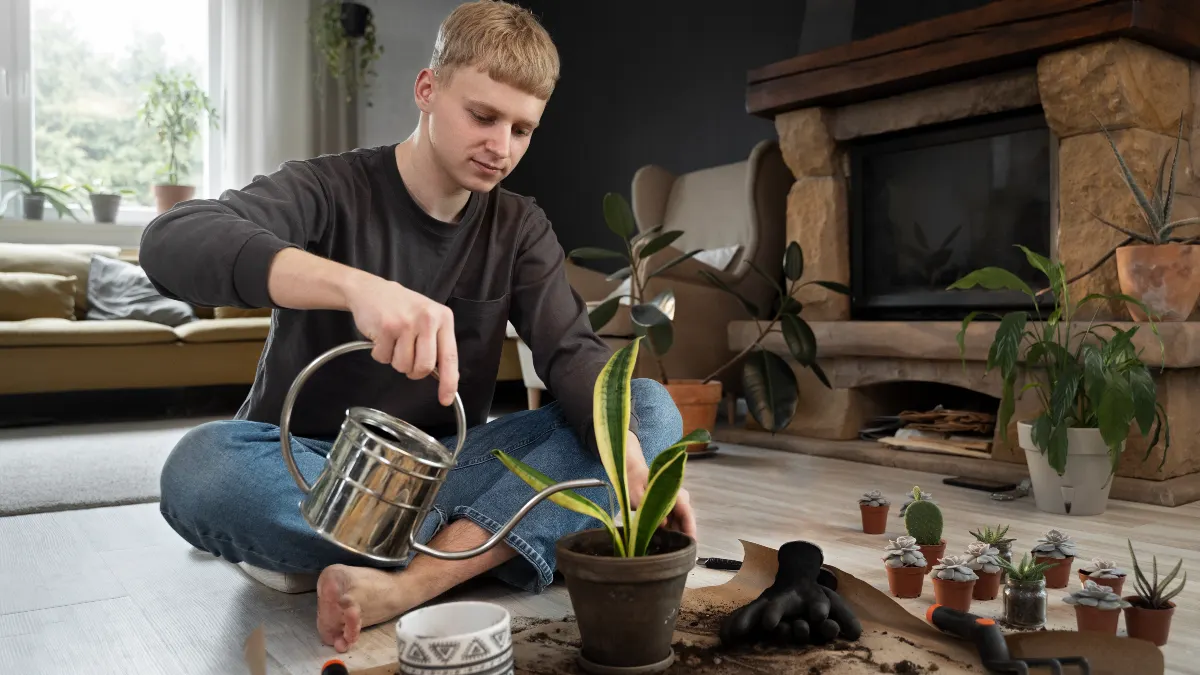
Use a soilless mix—skip garden soil. Houseplants do best in a soilless potting mix made from peat or coir plus bark and either perlite (drainage) or vermiculite (moisture-holding). Soilless media are lighter, better aerated, and less disease-prone than field soil; that’s why universities teach not to use garden soil in containers. (NC State Extension; Penn State Extension.)
Tweak the mix to match your watering habit. If you tend to overwater, blend in extra perlite to boost air pockets and drainage. If your plants dry out fast, add a little vermiculite for water retention. (UNH Extension’s container guidance and multiple extension media guides align on these roles.)
Pick the right pot material as a “guardrail.” Terracotta (unglazed clay) is porous—water evaporates through the sides, so soil dries faster (great for heavy waterers). Plastic or glazed ceramic slows drying, useful if you forget to water. (Colorado State PlantTalk.)
Size matters—don’t upsize too far. A bigger pot dries slower; if you jump multiple sizes, soil can stay wet long enough to risk root rot. Repot one size up only when roots circle the pot or water runs straight through. (UConn Extension; UConn Home & Garden Education Center, 2025.)
Quick recipe (general purpose): 2 parts all-purpose potting mix + 1 part fine bark + ½–1 part perlite. Chronic underwaterer? Swap some perlite for vermiculite. Label your bag “houseplant mix” so you don’t accidentally use garden soil later. (NC State, Penn State.)
Set-and-Forget Helpers: Lights, Timers, and Self-Watering
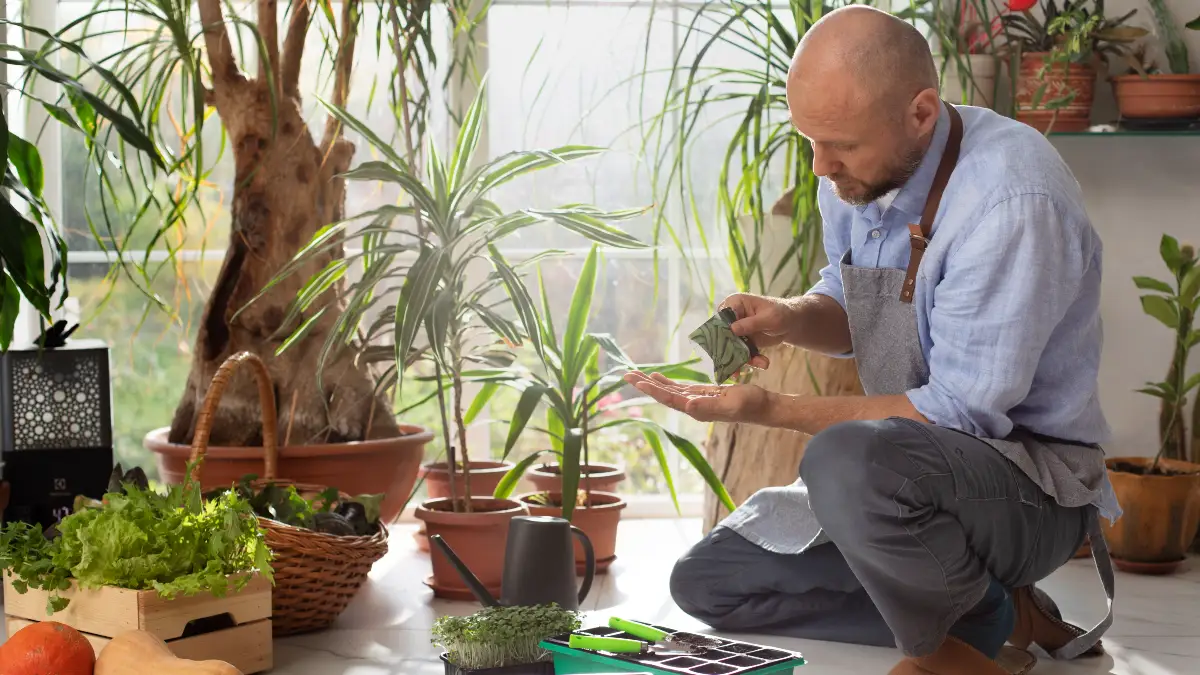
Put light on a timer and stop guessing. For tropical foliage, aim for 12–14 hours/day under LED grow lights; many flowering houseplants prefer 14–16 hours. Set a smart plug or mechanical timer and leave it. (University of Minnesota Extension; Iowa State Extension.)
Distance & placement. Keep LEDs roughly 12–24 inches above foliage for most indoor plants (closer for high-light species; follow the fixture’s guidance). Wipe dusty leaves monthly—they photosynthesize better. (UMN Extension.)
If you travel or forget: Self-watering planters with a wicking reservoir keep moisture steady and are excellent for beginners. In recent testing, Better Homes & Gardens (2025) highlighted several top performers; notably, Crescent Garden’s TruDrop design can stretch up to ~6 weeks between refills depending on plant and conditions. Use the fill gauge and still check the top inch of soil.
Optional pro move—measure light with your phone. The Photone app (Android/iOS) reads PPFD and DLI, translating “is this bright enough?” into numbers. Check at leaf height; if DLI is low, extend hours or move the light closer. (Photone on Google Play; App Store listing.)
Bottom line: A basic LED bar + a timer + (optionally) a self-watering pot removes two failure points—inconsistent light and erratic watering—so your plants cruise through seasons.
Fast Fixes to Common Problems
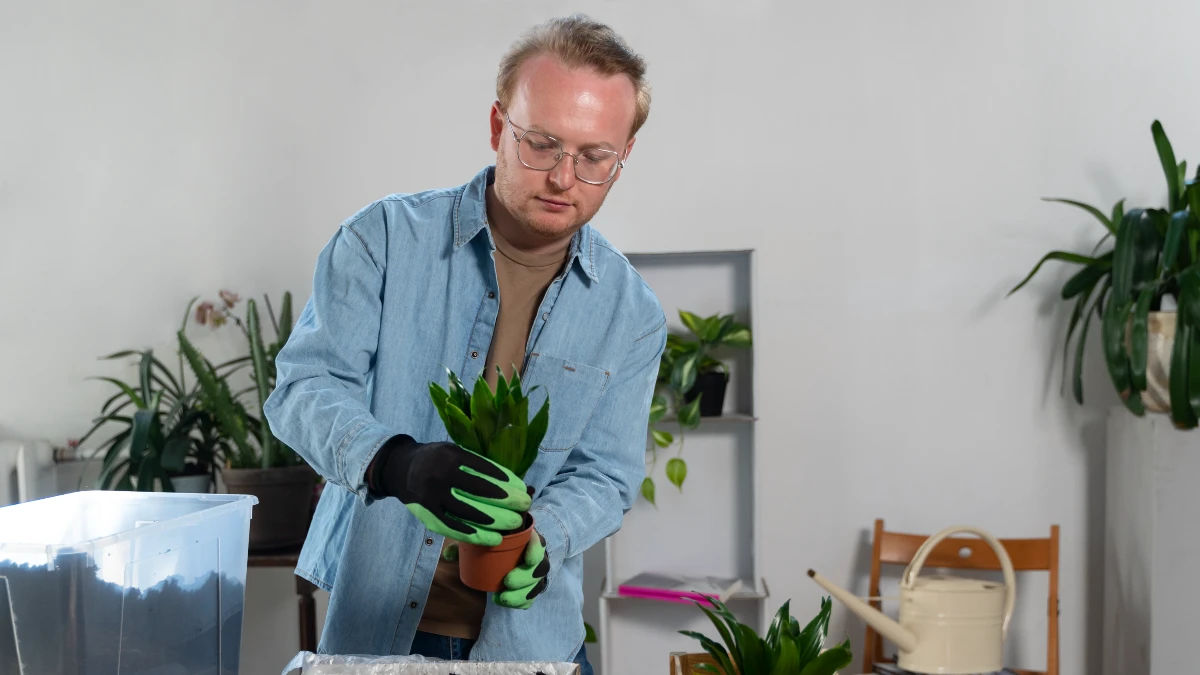
1) Looks sad and yellow? Soil smells swampy? That’s classic overwatering. Action plan: pause watering, empty saucers, and check roots. Healthy roots are firm and pale; mushy/brown roots mean rot—trim and repot into fresh, well-draining mix. Use sticky traps and let the top 1–2 inches dry if fungus gnats are present. (The Spruce, symptom/treatment overviews.)
2) Winter weirdness (slower growth, leaf drop). In winter, give more light and less water: move plants to brighter windows or run a grow light 12–14 h/day; allow longer dry-downs; keep them away from drafts and heat vents. Dust leaves so they can use the limited light. (WIRED’s 2025 expert roundup aligns with extension advice.)
3) Brown, crispy tips on spider plants or dracaena. These genera are often fluoride-sensitive. Switch to rain or distilled water and leach salts (slowly pour through extra water to flush). New growth should emerge clean even if old tips stay marked. (UF/IFAS Gardening Solutions.)
4) Myth check: “Plants purify indoor air.” Multiple reviews (including Drexel University) find typical home plant counts don’t measurably clean air compared with ventilation. Enjoy plants for stress relief and beauty—ventilate for air quality.
5) Quick prevention loop. Measure your light, water by dryness, use the right pot (terracotta for heavy waterers; plastic/glazed for forgetful waterers), and consider self-watering if your schedule is unpredictable. (Colorado State PlantTalk; BHG tests.)
Conclusion
Measure your light, choose forgiving species that match it, and water by dryness, not by the calendar. Let your pots, soil, and self-watering gear do the heavy lifting, and use a timer on grow lights to keep conditions steady. For homes with animals, run a quick ASPCA pet-toxicity check before you buy.
Start with two or three from the list—ZZ, snake plant, and either spider plant or parlor palm if you have pets. Set a 12–14-hour light timer, pick a pot style that fits your watering habit, and you’ll finally see the easiest indoor plants to grow for black thumbs thrive on your schedule.

